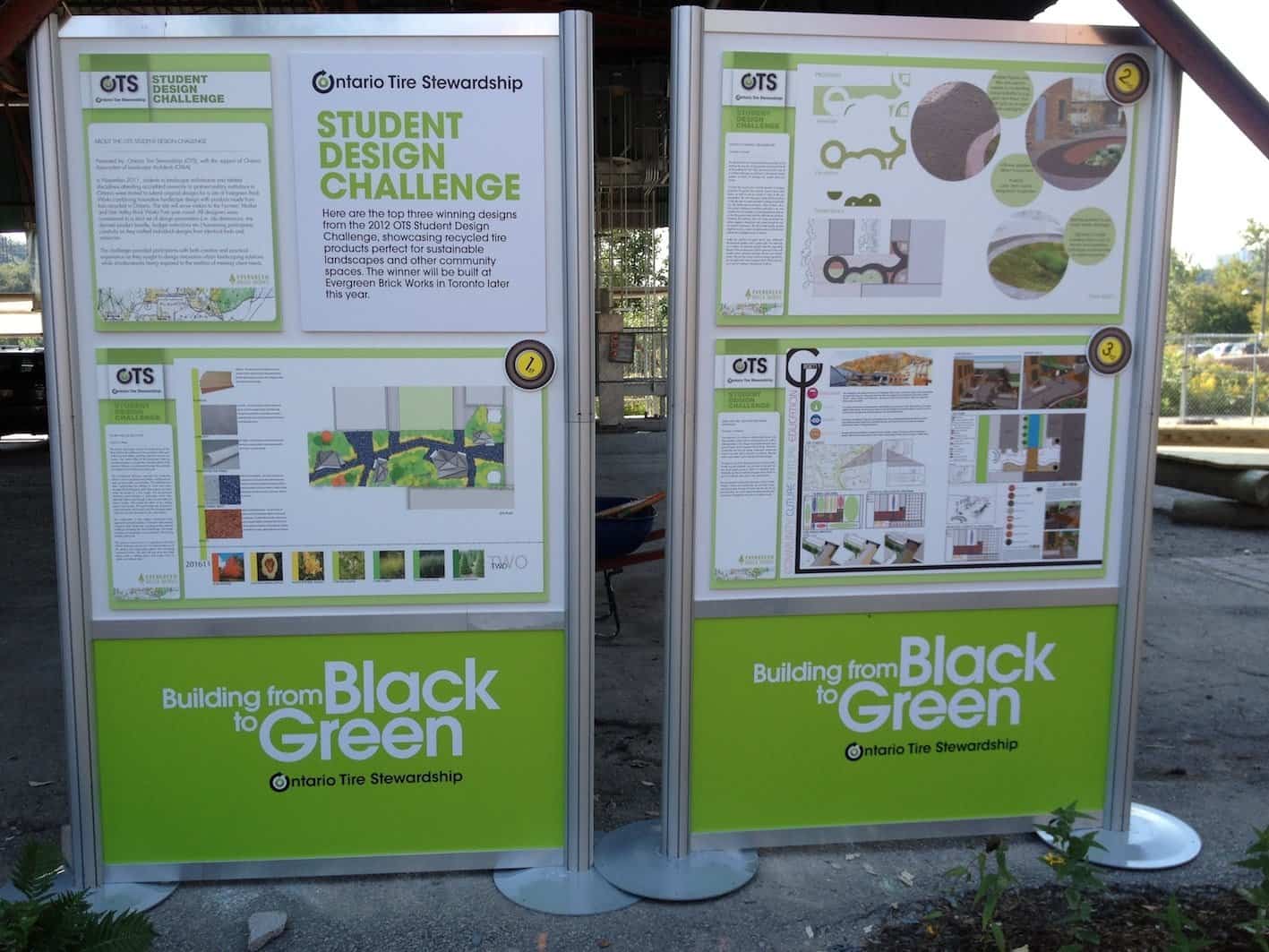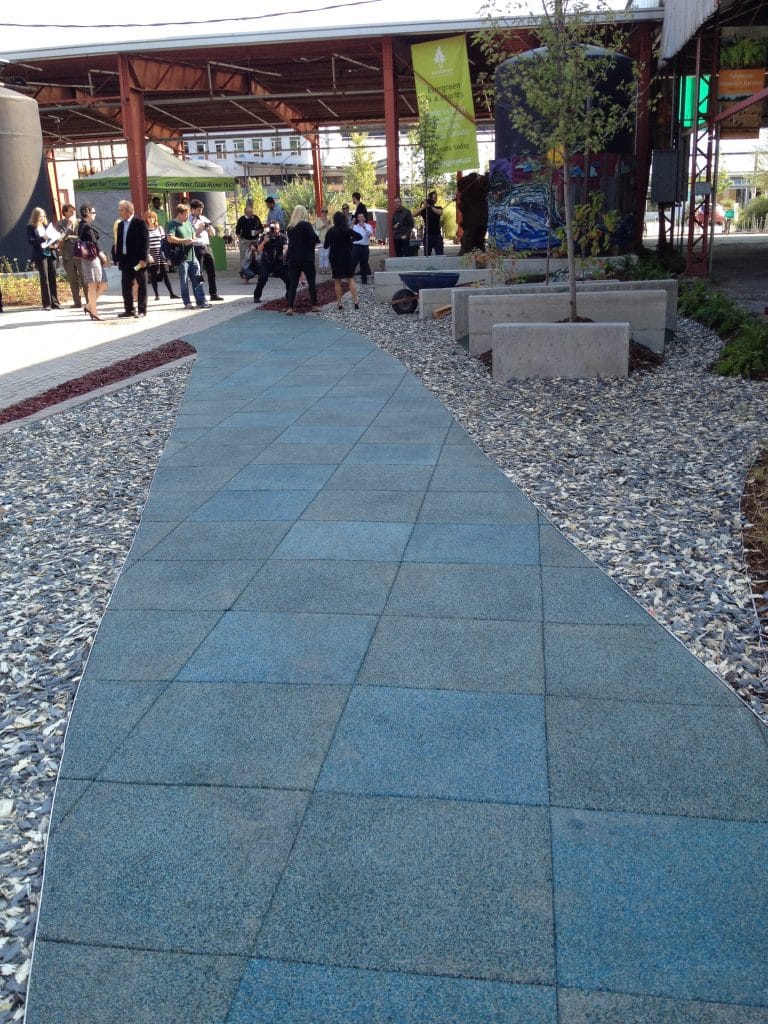I went to the official opening of a new site at Evergreen Brick Works in Toronto this week. The design of Gloria Perez and Jessica Gafic won the inaugural Ontario Tire Stewardship (OTS) Student Design Challenge, part of a contest held last fall by OTS with the support of the Ontario Association of Landscape Architects. Entrants were asked to create a new landscape feature using products made from recycled tires that would then be incorporated into the existing green space at Evergreen Brick Works, which includes a popular farmers’ market.

The fairly small space will be used as a walkway and rest area (or play area, depending on your mood or age) for families visiting the farmers’ market. The winding green-blue pathway, green rubber slopes (or “riverbanks”) on the sides, and grey and blue rubber mulch used to mimic the stones and rocks of a riverbed were chosen to represent the nearby Don River.
As a gardener, there were two things I immediately wanted to know more about: the plants and the rubber mulch made from recycled tires.
Evergreen Brick Works promotes the use of native plants in urban gardens, so it wasn’t surprising that all the plants used at the site were native plants, including silver maples, red maples and 600 to 800 perennials (a lot of ferns, and all flowers are either white or yellow). It was important that all the plants used in the design could also be found at the Evergreen Brick Works garden centre to purchase.
The trees had either rubber mulch or standard wood-chip mulch under them, partly as an experiment to see if there are differences in the growth and health of the trees in a few years. Elise Shelley, an independent landscape architect who oversaw the project and worked with the students on the practical application of their design, told me that putting the rubber mulch directly under the trees was done to encourage kids to run up underneath the trees and interact with them. It brings the trees more into the play area, and this incorporation of nature into urban life is a strong part of Evergreen Brick Works’ mandate.
I didn’t know there was such a thing as rubber mulch, but perhaps I’ve been out of the loop. I spoke to Dan Hefferman of Heffco Elastomers Inc. about the product, which has been on the market a few years.
Made with tires from off-road vehicles and forklift trucks, the rubber mulch I saw this week didn’t need to be dyed funky grey and blue to resemble stones, because the tires were already those colours. It’s shredded to mimic wood chips, though you can also find rubber mulch in more of a pellet shape. The rubber mulch doesn’t absorb water, so it lets water drain down into the soil — you can add soluble fertilizer on top of the mulch and it will wash down. The rubber mulch is also quite heavy, so you won’t find it blowing around a lot, and it won’t need to be replenished frequently. This is important, because rubber mulch does tend to cost more than regular mulch. As with other non-biodegradable mulches, however, it won’t enrich the soil, which organic mulches such as compost, shredded bark and shredded leaves do.

When I learned that the mulch came from tires, my immediate question was “aren’t there bad things in tires that will damage the plants or soil?” The answer is that the undesirable, non-biodegradable materials like oil and metal bits are eliminated.
I’ve always wondered about the colours people choose for their mulch. Beds of perennials with a bright red shredded bark mulch have never been my personal aesthetic — to me, the red resembles the desert, and those perennials don’t really look at home in the desert. Anyway, my curiosity led me to ask Dan about what colours are most popular. He told me that in the Toronto area, the reddish mulch is most popular, while the black mulch is the favourite in the London and western Ontario areas. I won’t speculate on why this is, but I always find these different preferences from one geographical area to the next interesting. Myself, I like mulch that looks natural, and this rubber mulch does come in brown, too.
We use a lot of water and natural resources to create our beautiful gardens, and recycling and reusing products is a fundamental way we can work on greening ourselves beyond just our thumbs. OSC receives government funding and has been gaining public support, and I realized the importance of their mission to recycle tires and put them to good use. Eighteen million new tires come into Ontario every year, and our old tires have typically ended up in landfills or as toxic fumes from tire fires.
Through the OSC’s program of free disposal of tires for the public, more tires are being broken down into “rubber crumb” that can then be used to make roof shingles, floor and patio tiles, mulch, and more. Since the beginning of the program in the early 1990s, the group has been spreading awareness by getting more drivers and auto shops to recycle tires, and 40 million tires have been recycled to become new products, like the nifty mulch at the new site at Evergreen Brick Works.
To make sure your tires get properly recycled, you can find one of the 6,300 registered tire collectors in Ontario at greenmytires.ca

